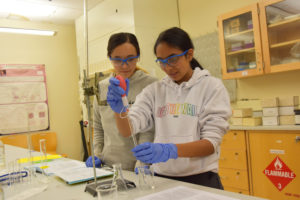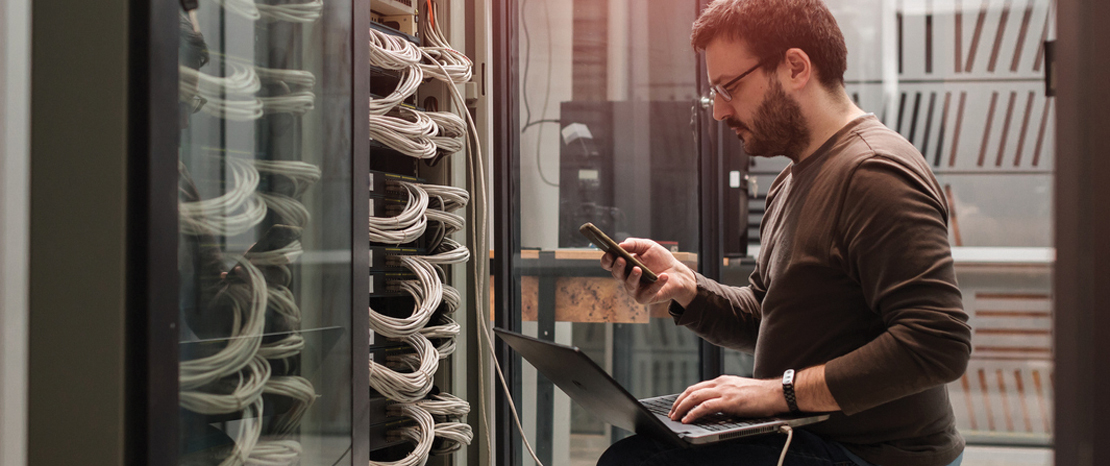
Photo: Margaret McKinney
August 18, 2021
The National Science Foundation awarded a $3.8 million grant to New Mexico Highlands University that will help advance the creation of high-performance plastics made from biomaterials and expand access to research, labs, and equipment for underrepresented students in the field.
The grant will fund a Partnership for Research and Education in Materials, or PREM, for Highlands and partner institutions the University of California Los Angeles and the University of California Santa Barbara. The grant will also create a science education pipeline for students from kindergarten up through college to expand access and interest in the sciences.
The National Science Foundation grant will provide funding across six years that will go towards 16 scholarships for both graduate and undergraduate students studying biology, chemistry, computer science, mathematics, and geology. The grant will fund travel, research, and publication opportunities for students, and will provide them with job skills for future employment.
“A lot of that money that we get will be to develop a cohort, both undergraduate and graduate,” said Gil Gallegos, professor of computer science at Highlands and the principal investigator for the project. “Many of them are from underrepresented groups—women, Hispanic, Asian, and many others. It’s really going to bring up the level of student that’s underrepresented in the country right now.”
While Highlands has participated in similar partnerships in the past, this particular partnership with UC-Santa Barbara and the National Science Foundation BioPACIFIC Materials Innovation Platform, or MIP, laboratory is unique. Javier Read de Alaniz is a professor of chemistry and biochemistry at UC-Santa Barbara and serves as the director of BioPACIFIC MIP, and he grew up in Las Vegas, New Mexico, and began his college education at Highlands.
“Most of the time you don’t have someone in my position at the partner institution who actually came from and knows what it’s like to grow up in the area,” said Read de Alaniz. “We’re hoping we can leverage that connection to strengthen our partnership by having representation or someone from northern New Mexico at both partner institutions.”
Last week, students and faculty from Highlands attended a virtual conference hosted by BioPACIFIC MIP to learn about the biomaterials projects they’ll be working on. According Read de Alaniz, current research in the BioPACIFIC MIP labs is focused on creating specialized plastics from yeast, fungi, and bacteria, rather than from petroleum. But so far, he said, they’ve only been able to run a small number of reactions at a time.
This is where Gallegos comes in. Gallegos’ area of expertise is machine learning and artificial intelligence and with his guidance, students from all three institutions will be learning how to analyze large data sets—something Highlands’ students already have some experience in.
“We’re excited because we’ve done some work with a one-year grant with the National Science Foundation,” Gallegos said. “We used machine learning and AI to analyze COVID-19 data on the Navajo Nation. So, this will be, another grant where we get to use machine learning and AI with a different application in material science.”
“If you can imagine, you used to run five reactions a week, and now you could maybe run 500 reactions a week using the high-throughput robotic platforms, choosing what those reactions are becomes much more important,” said Read de Alaniz. “Machine learning will allow us to use data to help us to rationalize what types of experiments to run, and then how to interpret all the data that’s coming out.”
In addition to using artificial intelligence to determine which reactions will be viable for material creation, Gallegos said that the team will also be able use machine learning to start with a desired material and work their way backward to discover what reactions to run.
“Now we’re going to use machine learning to figure out the molecular structures to then build that material,” Gallegos said. “That’s where we come in—to analyze their data and make more informed decisions that, in the past, would have taken probably years of analysis of these complex data sets.”
The field of biomaterials is vast and has many applications in the fields of medicine, technology, and beyond, according to Gallegos and Read de Alaniz. Biomaterials can be used for skin grafting, desalination, biodegradable plastics, and battery power, among many other uses.
“The types of polymers that they will be making will be used for a range of applications such as MRI contrast agents, magnetic materials, and materials that can store gases like hydrogen and carbon dioxide,” said Read de Alaniz. “The last two would be used for fuel or would be critical for capturing greenhouse gases.”
Read de Alaniz said he’s excited about the materials that will be developed as the result of the partnership—an enthusiasm that Gallegos shares.
“Nature’s had millions of years to get it, right,” said Gallegos. “We might be able to evolve further with the use of deep learning. And that’s the exciting part is when you go beyond what nature gives you but you use nature as the seed for the idea.”
In addition to Gallegos, the Highlands University team includes chemistry professor Tatiana Timofeeva, geology professor Michael Petronis, chemistry professors Shipra Gupta, Luis Raul Castaneda Perea, and Naveen Singh, and the director of the university’s center for Achievement in Research, Math and Science, Kelly Trujillo. Trujillo will be spearheading the educational component of the grant, which includes community outreach and hands-on teaching opportunities for undergraduate and graduate assistantships.
“We want to create a pipeline that goes from kindergarten all the way up through the PhD level,” said Gallegos. “Kelly Trujillo will start to identify the kids that are interested and we’ll go to the local schools and demonstrate, with graduate students or undergraduate students, some of the technologies we have.”
Gallegos said that Highlands students will help to run summer science camps where kids might learn the structures of organic matter or how to do basic coding. However, Highlands students will be primarily focused on research and training in biomaterials and machine learning.
“Industry already uses high-throughput, reaction design, robotics, machine learning—but none of that is taught at school right now. We’re so far behind,” Read de Alaniz said. “The center will really give New Mexico Highlands students hands-on experience with state-of-the-art equipment, providing a competitive advantage when they are looking for jobs. And that’s true for our students at UCSB and UCLA as well.”

